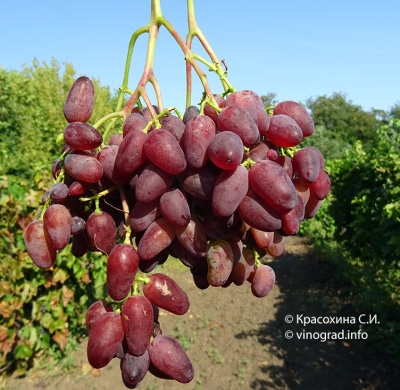
- Authors: VNIIViV Potapenko
- Appointment: dining room
- Berry color: dark pink
- Taste: harmonious
- Ripening period: very early
- Frost resistance, ° C: -25
- Name synonyms: II-13-6-2
- Bunch weight, g: 572
- Flower type: bisexual
- Tasting assessment, points: 8,1
Amethyst Novocherkassky is a great option to learn how to grow grapes on your own plot for the table. In addition to high yields, this variety also exhibits excellent transportability.
Breeding history
Thanks to the work of VNIIViV them. Ya. I. Potapenko the variety was born when two other species were crossed: Red Delight and Delight.
Geography of distribution
Today Amethyst Novocherkassky has a rich geography of distribution. It is grown in many regions of our country.
Description
As mentioned above, these are table grapes. Flowers of both sexes are formed on the shoots, which is another of its advantages.
If we talk about the strength of growth, then it is characterized as above average. The percentage of fruitful shoots on the bush is 73.9.
Ripening period
The grape variety Amethyst Novocherkassky belongs to crops with a very early ripening period.
Bunches
Conical bunches are of medium density. By weight, this is approximately 572 grams per bunch.
Berries
Beautiful dark pink berries accumulate a sugar level of 153 g / dm³ by ripeness. The acidity level is 5.7 g / dm³.
The fruit has a thin skin, fleshy, juicy pulp is hidden inside. The grapes are elongated, each weighing about 6.2 grams. The tasting score is at 8.1 points.
Taste
The taste of the described variety can be characterized as harmonious.
Yield
Amethyst Novocherkasskiy belongs to high-yielding varieties.


Growing features
Too much or too little heat causes serious problems when growing a variety. It is best to plant on the south side, where there is no draft. Special attention to watering. A large amount of moisture is always a problem with gray mold.
Landing
When planting, a lot of attention is paid to the organization of the landing pit. The main thing is to choose the right size, organize drainage.
In terms of dimensions, it is worth relying on the size of the rhizome of the seedling. The pit should be 2 times larger. If planted in fertile soil, then fertilizers can not be used, if sandstone, then you can not do without them.

Pollination
All grape varieties with bisexual flowers do not require additional pollination.
Pruning
Vines are pruned with 6-8 eyes per vine. There is a need for normalization.

Watering
Young seedlings cannot be left without moisture, so they are watered every week, but taking into account that there is no heavy rain.Adult plants have a developed root system, so they should only be watered if there is a long drought.


Top dressing
Regular application of balanced fertilization throughout the growing season will benefit the vines. You can use both complex mixtures and organic compounds, for example, horse or cow manure, but always rotted.
Frost resistance and the need for shelter
In the southern regions, shelter is not required, since the frost resistance of this variety is -25 degrees Celsius. In regions where temperatures can drop below this level, cover material should be used.

Diseases and pests
The vine does not have many diseases and pests, but the Novocherkassky Amethyst variety can be affected by black rot and powdery mildew.
Black rot loves rainy weather and can be difficult to control. It is best to remove all mummified fruit from the vines. It is also best to apply appropriate fungicides to control the disease.
Powdery mildew creates a white film on the leaves and a powdery build-up on the fruit. This fungus loves warmth and high humidity. The best way to deal with powdery mildew is to plant your vines with good air circulation between the bushes.
In the fight, sulfur or a copper-based fungicide is used.

If a grape is exposed to any disease or insect, this always affects its appearance.
Storage
The grapes are perfectly stored after harvest and can be transported over long distances without losing their presentation.











































































